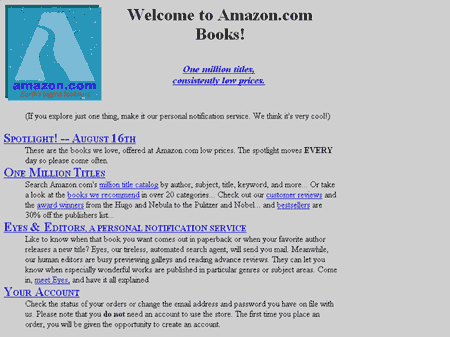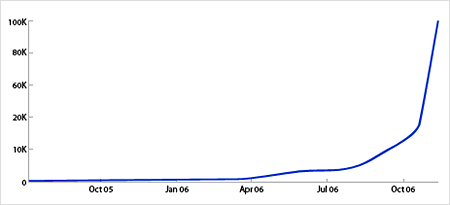Slide, the company I work for, recently announced that we raised a round of financing. The additional funds will help us grow faster as we ramp up our infrastructure and bring on more engineers and designers to build out our service. It also adds Vinod Khosla, co-founder of Sun Microsystems and former general partner at Kleiner Perkins Caufield & Byers to our team.
Raising money can also draw criticism, as people look at your company and question its value and ability to succeed. Liz Gannes from GigaOm mentioned that “we (GigaOm) can’t say we get the big idea.”
Criticism is fair. Far too many companies have squandered investor dollars on services that were ill conceived and poorly managed. But it’s also hard to predict the future.
Consider the Yahoo! homepage in 1994:

It’s hard to imagine this is a company that in 10 years would grow to having a market capitalization in the tens of billions, and would become one of the top two, if not the most, trafficked Internet site in the world.
Or consider Amazon’s homepage when it was founded in 1995:

When I heard of a company selling books online I thought the idea was niche at best. I was wrong. Amazon is now the largest online shopping site. When it was founded in 1995, it had 11 employees by the end of the year. Within four years, it had more than 1,600 employees and four million customers.
As John Gruber of Daring Fireball notes, the success of products and service typically come after a long journey of incremental improvements, rather than overnight success:
“The most remarkable thing about Apple’s iPod/iTunes platform is how incrementally it has grown. These annual iPod/iTunes special events garner tremendous fanfare, and deservedly so, but it’s really just been one small evolutionary step after another.
“It started with nothing more than a $399 5GB Mac-only MP3 player and a Mac-only jukebox app. Then they officially supported Windows, albeit without iTunes, and only on PCs equipped with FireWire. Then the iTunes Music Store, still Mac-only. Then the Windows version of iTunes. The expansion to a family of iPods: the Mini. Then photos and color screens. The Shuffle. Then, a year ago, the Nano and video iPods. And, now, after a year of selling 30- and 60-minute TV shows, feature-length motion pictures. Walk, jog, run.
“Steady, consistent improvement and expansion, one step at a time — and now it’s a juggernaut.”
Slide has come a long way since we launched the service at the end of August 2005. Slide hasn’t released any numbers about our service usage, so all I can really do is point you to publicly available information. For example, I’ve graphed the number of links from blogs that we’ve received (according to Technorati) since we launched.

The growth is exponential.
As Reuters reports, The Hitwise numbers for October also reflect Slide’s strong growth:
“Slide ranks as the sixth-most-visited US photo entertainment site, according to Web measurement firm Hitwise Inc, attracting more visitors than sites such as Snapfish and Shutterfly. In terms of visitors, it is neck and neck with Yahoo Inc.’s Flickr in the category.”
Hitwise tracks only US Internet usage, and I suspect if we were to look worldwide, Flickr would pull ahead. That said, it’s impressive to see this type of growth through what is basically word-of-mouth distribution. Slide doesn’t spend money on advertising.
Another criticism is that Slide is not, at this point, revenue focused. The success of Slide, long term, is ultimately tied to how well we can monetize our service. But it’s important to keep in mind that for a startup at the early phase, being overly concerned with profits can actually be problematic, as Paul Graham notes:
“The idea of building something popular then figuring out how to make money from it was born in the Bubble. It sounds irresponsible, but it works. Requiring founders to have a carefully worked out plan for making money is not hard-headed business sense. It’s what hackers call ‘premature optimization.’ The really important thing is to make something people want.”
This leaves us with two certainties:
1. Slide has come a long way.
2. It’s hard to predict the future.
![]()
Recent Posts
- When Good Design Isn't Enough
- What is Design?
- Dick Costolo is a Lot Smarter Than I Am
- Premature Optimization
- Personality
[…] to Predict the Future: Slide’s Johnnie Manzari answers critics. ReTweetBuzz it!0 […]